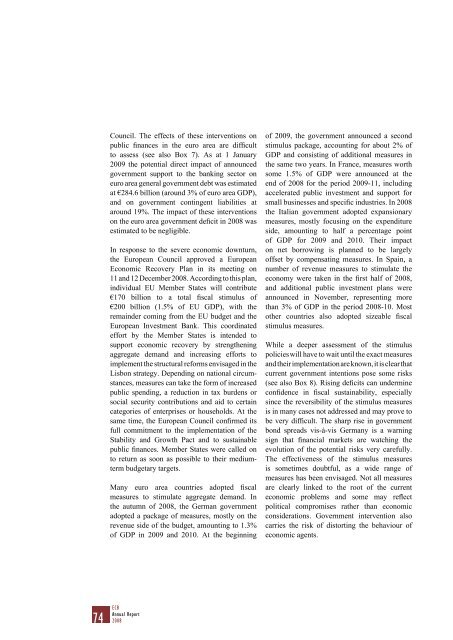ANNUAL REPORT 2008 - Polymer Bank Notes of the World
ANNUAL REPORT 2008 - Polymer Bank Notes of the World
ANNUAL REPORT 2008 - Polymer Bank Notes of the World
You also want an ePaper? Increase the reach of your titles
YUMPU automatically turns print PDFs into web optimized ePapers that Google loves.
Council. The effects <strong>of</strong> <strong>the</strong>se interventions onpublic finances in <strong>the</strong> euro area are difficultto assess (see also Box 7). As at 1 January2009 <strong>the</strong> potential direct impact <strong>of</strong> announcedgovernment support to <strong>the</strong> banking sector oneuro area general government debt was estimatedat €284.6 billion (around 3% <strong>of</strong> euro area GDP),and on government contingent liabilities ataround 19%. The impact <strong>of</strong> <strong>the</strong>se interventionson <strong>the</strong> euro area government deficit in <strong>2008</strong> wasestimated to be negligible.In response to <strong>the</strong> severe economic downturn,<strong>the</strong> European Council approved a EuropeanEconomic Recovery Plan in its meeting on11 and 12 December <strong>2008</strong>. According to this plan,individual EU Member States will contribute€170 billion to a total fiscal stimulus <strong>of</strong>€200 billion (1.5% <strong>of</strong> EU GDP), with <strong>the</strong>remainder coming from <strong>the</strong> EU budget and <strong>the</strong>European Investment <strong>Bank</strong>. This coordinatedeffort by <strong>the</strong> Member States is intended tosupport economic recovery by streng<strong>the</strong>ningaggregate demand and increasing efforts toimplement <strong>the</strong> structural reforms envisaged in <strong>the</strong>Lisbon strategy. Depending on national circumstances,measures can take <strong>the</strong> form <strong>of</strong> increasedpublic spending, a reduction in tax burdens orsocial security contributions and aid to certaincategories <strong>of</strong> enterprises or households. At <strong>the</strong>same time, <strong>the</strong> European Council confirmed itsfull commitment to <strong>the</strong> implementation <strong>of</strong> <strong>the</strong>Stability and Growth Pact and to sustainablepublic finances. Member States were called onto return as soon as possible to <strong>the</strong>ir mediumtermbudgetary targets.Many euro area countries adopted fiscalmeasures to stimulate aggregate demand. In<strong>the</strong> autumn <strong>of</strong> <strong>2008</strong>, <strong>the</strong> German governmentadopted a package <strong>of</strong> measures, mostly on <strong>the</strong>revenue side <strong>of</strong> <strong>the</strong> budget, amounting to 1.3%<strong>of</strong> GDP in 2009 and 2010. At <strong>the</strong> beginning<strong>of</strong> 2009, <strong>the</strong> government announced a secondstimulus package, accounting for about 2% <strong>of</strong>GDP and consisting <strong>of</strong> additional measures in<strong>the</strong> same two years. In France, measures worthsome 1.5% <strong>of</strong> GDP were announced at <strong>the</strong>end <strong>of</strong> <strong>2008</strong> for <strong>the</strong> period 2009-11, includingaccelerated public investment and support forsmall businesses and specific industries. In <strong>2008</strong><strong>the</strong> Italian government adopted expansionarymeasures, mostly focusing on <strong>the</strong> expenditureside, amounting to half a percentage point<strong>of</strong> GDP for 2009 and 2010. Their impacton net borrowing is planned to be largely<strong>of</strong>fset by compensating measures. In Spain, anumber <strong>of</strong> revenue measures to stimulate <strong>the</strong>economy were taken in <strong>the</strong> first half <strong>of</strong> <strong>2008</strong>,and additional public investment plans wereannounced in November, representing morethan 3% <strong>of</strong> GDP in <strong>the</strong> period <strong>2008</strong>-10. Mosto<strong>the</strong>r countries also adopted sizeable fiscalstimulus measures.While a deeper assessment <strong>of</strong> <strong>the</strong> stimuluspolicies will have to wait until <strong>the</strong> exact measuresand <strong>the</strong>ir implementation are known, it is clear thatcurrent government intentions pose some risks(see also Box 8). Rising deficits can undermineconfidence in fiscal sustainability, especiallysince <strong>the</strong> reversibility <strong>of</strong> <strong>the</strong> stimulus measuresis in many cases not addressed and may prove tobe very difficult. The sharp rise in governmentbond spreads vis-à-vis Germany is a warningsign that financial markets are watching <strong>the</strong>evolution <strong>of</strong> <strong>the</strong> potential risks very carefully.The effectiveness <strong>of</strong> <strong>the</strong> stimulus measuresis sometimes doubtful, as a wide range <strong>of</strong>measures has been envisaged. Not all measuresare clearly linked to <strong>the</strong> root <strong>of</strong> <strong>the</strong> currenteconomic problems and some may reflectpolitical compromises ra<strong>the</strong>r than economicconsiderations. Government intervention alsocarries <strong>the</strong> risk <strong>of</strong> distorting <strong>the</strong> behaviour <strong>of</strong>economic agents.74 ECBAnnual Report<strong>2008</strong>




![KNOW YOUR NEW GIBRALTAR BANKNOTES - [Home] bThe/b](https://img.yumpu.com/50890985/1/184x260/know-your-new-gibraltar-banknotes-home-bthe-b.jpg?quality=85)
![PAPUA NEW GUINEA - [Home] - Polymer Bank Notes of the World](https://img.yumpu.com/49758743/1/190x143/papua-new-guinea-home-polymer-bank-notes-of-the-world.jpg?quality=85)










